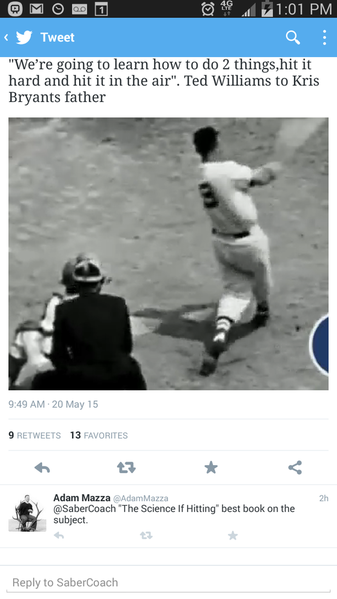Please never take a post from me as an attack on you or anyone else. I apologize if my posts or a post comes off this way. I respect everyone's opinion and their right to voice it. My approach to hitting is no different than my approach to fielding. Or running the bases. Or any part of the game of baseball. For instance. You can teach kids to field the baseball in a standard way. They will probably make less errors. They will probably get to less balls to make errors on. But it's much easier to teach. It doesn't take as much athletic ability to do. Get in front of the ball, reach, bend, gator, transfer, step and throw. Or you can teach your players to be athletic players who play through the baseball. Attack, glove, transfer and throw. One approach is safer. Allows for more routine plays to be made without errors "initially." That will never transfer to the next level. That will never allow the player to be the best he could have been. The other approach will. You just have to be willing to live with the growing pains. Be willing to actually teach it. Like base running. You can micro manage the game from the 3B box. Teach your players to watch you. Or teach them to run the bases as their own coach. Learning to read gloveside throws, backhand throws, hard approaches, soft approaches, ball in front of you, ball behind you, etc. That split second where they are waiting for you to tell them what to do vs them making the call based on experience of having to make the calls.
What we are talking about here is taking a kid and teaching him to produce ground balls vs teaching him how to actually hit. Why would you do that? Because hitting ground balls produces more opportunities to win at the level you are playing. Because it's easier for a kid to just put the ball in play than it is to teach him how to actually hit. Now at what point does a player reach the point where he is that guy? When he is a freshman in HS? When he is the scrub on the 12u team? When he is the little kid on the 9u team? Oh your fast and you have no power if you just learn how to slap it in the dirt you will reach much more than if you try to crush it.
My point is that you can take a kid with the same amount of ability and teach him to attempt to produce line drives just as easily as you can attempt to teach him to produce ground balls. It's crazy to me. We have coaches teaching QAB mentality to 9u players. See pitches. Don't swing on 2-0 3-1 counts. Work BB's. Take HBP. Foul it off and work counts. And the kid learns how to actually hit when?
Hitting is not a job. "Do your job." I get so sick of hearing this at the youth and HS levels. It's not a job. It should be the most fun part of the game. Get up there and look to mash the baseball. Have some fun. Hunt a pitch. Hunt the pitcher. Hammer a mistake. But now it's a passive approach being taught these young kids all in the name of giving us a better opportunity to win the game. So when do they actually learn how to hit the freaking baseball?
Fouling off cock shots and taking balls and getting rewarded by the coach for a QAB is BS. Teaching kids to just put the ball in play is BS. Teaching kids to squat on ground balls because you don't want them to make errors harkens back to the days of teaching outfielders to take a knee and keep the ball in front. Play the freaking game. Attack the game. Hit the ball in the face. Throw the freaking ball. I would rather you throw it in the stands than bounce it out of fear. I would rather you K looking to mash than hit a routine gb on a weak as s swing because you were afraid you were going to K.
Now maybe I could won a few more games. But my players wouldn't have been who they were. And they sure wouldn't have had as much fun. And I can live with that. All day long. Now that is just my opinion. It's not an attack. And I certainly won't take any negative responses as an attack on me. I believe in teaching players to hunt the game. Attack the game. Run as fast as you can. Throw it as hard as you can. Hit it as far and hard as you can. And have some fun. That is all.


